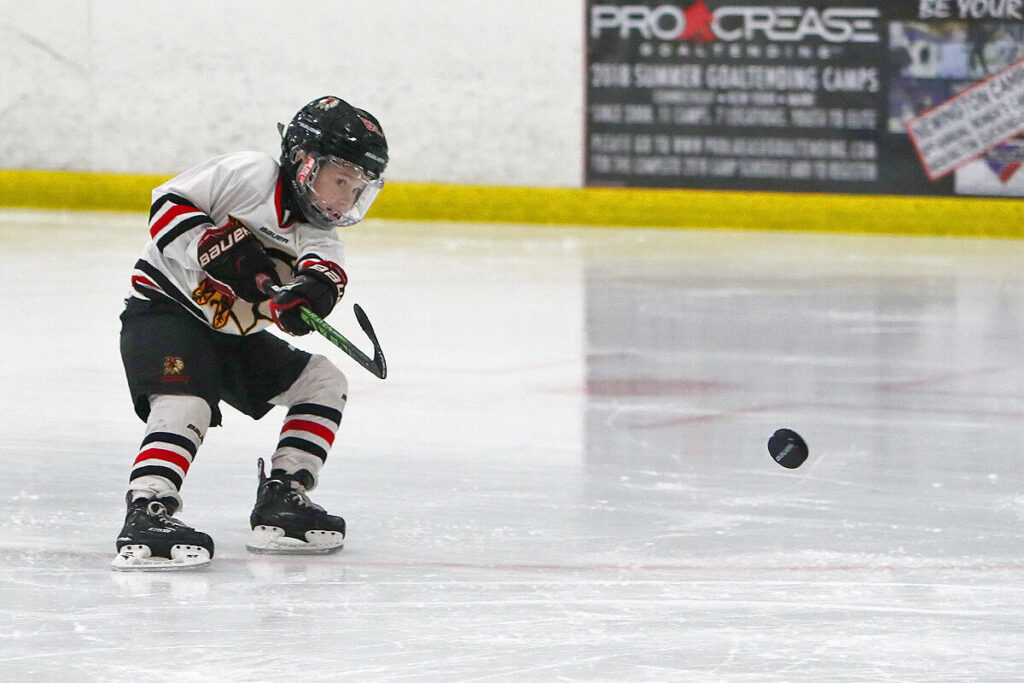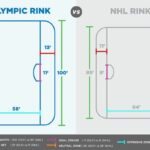To lift the puck in hockey, angle your stick and use a quick wrist snap. This technique elevates the puck off the ice.
Mastering the skill of lifting the puck is essential for any hockey player. This technique not only helps in scoring goals but also in effective passing. Proper stick handling and wrist movement are crucial. Players need to practice angling their stick and executing a swift wrist snap.
Consistent practice can significantly improve accuracy and control. Effective puck lifting can make a significant difference during a game. It allows players to maneuver around defenders and aim for the top corners of the net. Developing this skill enhances overall gameplay and increases scoring opportunities.

Credit: m.youtube.com
Introduction To Lifting The Puck
Learning how to lift the puck in hockey is a crucial skill. It allows players to make more accurate shots and passes. This technique can change the outcome of a game.
Importance Of Puck Lifting
Understanding the importance of puck lifting helps improve your game. Here are some key reasons:
- Better Accuracy: Lifting the puck helps in making accurate shots.
- Goal Scoring: It increases the chances of scoring goals.
- Passing Efficiency: Elevated passes can avoid defenders easily.
- Breaking Defense: It helps in breaking through tight defenses.
Common Scenarios For Use
There are various scenarios where lifting the puck is beneficial. Here are a few common ones:
- During a Breakaway: Lifting the puck can beat the goalie.
- Power Play: Elevated shots are harder to block.
- Penalty Shots: Lifting the puck can confuse the goalie.
- Passing Over Sticks: Helps avoid intercepts by defenders.
Mastering the puck-lifting technique can greatly improve your hockey performance. Start practicing today to see immediate improvements in your game.
Essential Equipment
Mastering the art of lifting the puck in hockey demands the right equipment. With the best gear, you can improve your technique and accuracy. Below are essential items to consider:
Choosing The Right Stick
The hockey stick is your primary tool. Choosing the right one is crucial. Here are some key factors:
- Length: The stick should reach your chin while you’re on skates.
- Flex: A lower flex rating helps kids lift the puck more easily.
- Blade Curve: Look for a mid-toe curve to help lift the puck better.
- Material: Composite sticks are lighter and more durable.
| Stick Feature | Recommendation |
|---|---|
| Length | Reaches chin on skates |
| Flex | Lower rating for kids |
| Blade Curve | Mid-toe curve |
| Material | Composite |
Optimal Skates For Balance
Skates play a big role in balance and control. Here’s what to look for:
- Fit: Snug fit ensures better control and agility.
- Blade Profile: A rounded profile offers better maneuverability.
- Support: Good ankle support helps maintain balance.
- Material: Lightweight material allows for quicker movements.
With the right stick and skates, lifting the puck becomes easier. Focus on these equipment essentials to improve your game.
Fundamental Techniques
Learning how to lift the puck in hockey is essential. It helps players make accurate shots and effective passes. This section breaks down fundamental techniques to master this skill.
Proper Grip
To lift the puck, start with the proper grip. Hold your stick firmly but not too tight. Place your top hand near the end of the stick. Your bottom hand should be lower, around the middle. This grip gives you control and power.
Top Hand: Provides stability and control.
Bottom Hand: Provides power and direction.
Body Positioning
Your body positioning is crucial. Stand with your knees slightly bent. Keep your weight on your back foot. This stance helps you generate power. Lean forward slightly to maintain balance.
- Knees Bent: Ensure better control and balance.
- Weight on Back Foot: Helps to generate power.
- Lean Forward: Maintains stability.
As you prepare to shoot or pass, shift your weight forward. This shift helps to lift the puck effectively. Your stick should be angled slightly. This angle helps scoop the puck off the ice.

Credit: www.tiktok.com
The Wrist Shot
The wrist shot is a vital skill in hockey. It allows you to lift the puck with precision. Mastering this shot can improve your game significantly.
Hand Placement
Hand placement is crucial for a successful wrist shot. Place your bottom hand halfway down the stick. Your top hand should be at the top of the stick. This grip gives you control and power. It allows for better puck lift.
Follow Through
The follow through is the final step in a wrist shot. Start with the puck near your back foot. Push forward and snap your wrists. Your stick should point where you want the puck to go. Follow through high to lift the puck. This ensures the puck rises off the ice.
| Step | Action |
|---|---|
| 1 | Place bottom hand halfway down the stick |
| 2 | Top hand at the top of the stick |
| 3 | Start puck near back foot |
| 4 | Push forward and snap wrists |
| 5 | Point stick where you want the puck to go |
| 6 | Follow through high to lift the puck |
- Hand placement: Bottom hand halfway down, top hand at top.
- Start position: Puck near back foot.
- Action: Push forward, snap wrists, follow through high.
The Snap Shot
The snap shot in hockey is a quick, powerful shot. It combines the speed of a wrist shot with the power of a slap shot. Mastering the snap shot can make you a deadly scorer on the ice.
Quick Release
A quick release is key in the snap shot. Keep your hands close together on the stick. This helps you react faster. Your top hand should do most of the work. Pull it towards your body as you shoot.
Bend your knees slightly. This gives you a lower center of gravity. It helps you balance better. Transfer your weight from your back foot to your front foot. This adds power to your shot.
- Keep your hands close
- Bend your knees
- Transfer weight
Accuracy Tips
Accuracy is just as important as power. Aim for the corners of the net. Goalies find it harder to block shots aimed at the corners. Keep your eyes on your target as you shoot.
Practice controlling the puck. This helps you aim better. Use the blade of your stick to guide the puck. Keep the puck close to the heel of your stick. This gives you more control.
- Aim for corners
- Keep eyes on target
- Practice puck control
Practice Drills
| Drill | Description |
|---|---|
| Quick Release Drill | Practice shooting quickly from different angles. |
| Accuracy Drill | Shoot at targets placed in the corners of the net. |
| Control Drill | Stickhandle through cones before taking a shot. |
The Slap Shot
The slap shot is a powerful and dynamic move in hockey. It’s a technique that involves striking the puck with great force, making it fly fast and high. Mastering the slap shot can give any player a significant edge on the ice. Below, we will explore the key components of a successful slap shot, focusing on the wind-up mechanics and power generation.
Wind-up Mechanics
The wind-up is the first step in executing a slap shot. Proper wind-up mechanics are essential for generating maximum power and accuracy.
- Position your body: Stand with your knees bent and your weight balanced.
- Grip the stick: Hold the stick with both hands, ensuring a firm grip.
- Pull the stick back: Bring the stick back, creating a large arc.
- Rotate your hips: Turn your hips to face the puck, aligning your body for the shot.
Power Generation
Generating power is crucial for a successful slap shot. By combining strength and technique, you can make the puck soar.
- Shift your weight: Transfer your weight from your back foot to your front foot.
- Snap your wrists: Use a quick wrist snap to add velocity to the shot.
- Follow through: Ensure your stick follows through in the direction of the shot.
| Step | Description |
|---|---|
| 1 | Position your body with knees bent and balanced weight. |
| 2 | Grip the stick firmly with both hands. |
| 3 | Pull the stick back, creating a large arc. |
| 4 | Rotate your hips to face the puck. |
| 5 |
Advanced Drills
Want to master lifting the puck in hockey? Advanced drills can help. These drills improve accuracy and control. You will learn to lift the puck with precision.
Target Practice
Target practice is key to improving accuracy. Use cones or small nets as targets. Focus on hitting these targets consistently.
- Set up multiple targets.
- Stand at different distances.
- Try to hit each target with a lifted puck.
This drill helps you aim accurately. It also builds confidence. Practicing regularly will enhance your puck-lifting skills.
Puck Handling
Good puck handling is essential. It allows you to lift the puck effectively. Work on controlling the puck with your stick.
| Drill | Description |
|---|---|
| Figure Eights | Move the puck in a figure-eight pattern around cones. |
| Stickhandling | Practice moving the puck back and forth quickly. |
| Toe Drags | Drag the puck with the toe of your stick. |
These drills enhance your control. They make lifting the puck easier. Practice them daily for best results.
Common Mistakes
Learning how to lift the puck in hockey can be tricky. Many players make common mistakes that prevent them from mastering this skill. Let’s explore some of these mistakes and how to avoid them.
Improper Technique
Using the wrong technique is a major issue. Players often fail to position their stick correctly. This makes it hard to lift the puck. Ensure the blade is under the puck and angled slightly up.
Gripping the stick too tight is another mistake. A loose grip allows more control. Also, bending your knees helps. It provides better balance and power. Keep your eyes on the puck. This helps with accuracy and timing.
Lack Of Follow Through
Another common mistake is the lack of follow through. Many players stop their motion too soon. This reduces the puck’s lift and accuracy. Always complete your swing. Your stick should point towards the target after the shot.
Keep your wrists flexible. Stiff wrists limit the puck’s elevation. Practice makes perfect. Consistent practice helps develop muscle memory. This leads to better follow through and improved puck lift.
Training And Conditioning
Training and conditioning are key in learning how to lift the puck in hockey. Your body needs to be strong and flexible. This will help you control the puck better. Below are important exercises to focus on.
Strength Exercises
Strength is crucial for lifting the puck. Here are some exercises to improve your strength:
- Squats: Build leg strength. Use weights for better results.
- Deadlifts: Enhance your back and leg muscles. Keep your back straight.
- Push-Ups: Strengthen your upper body. Aim for sets of 10-15 reps.
- Planks: Improve core stability. Hold for 30-60 seconds.
| Exercise | Muscle Group | Reps/Sets |
|---|---|---|
| Squats | Legs | 3 sets of 12 reps |
| Deadlifts | Back and Legs | 3 sets of 10 reps |
| Push-Ups | Upper Body | 3 sets of 15 reps |
| Planks | Core | 3 sets of 60 seconds |
Flexibility Workouts
Flexibility is just as important as strength. It helps you move smoothly. Try these workouts to stay flexible:
- Hamstring Stretches: Stretch your legs. Hold for 30 seconds each side.
- Hip Flexor Stretches: Open up your hips. Hold for 30 seconds each side.
- Shoulder Stretches: Stretch your shoulders. Hold for 30 seconds each side.
- Cat-Cow Pose: Increase your spine flexibility. Do for 1 minute.
Combining strength and flexibility exercises will improve your puck control. Practice regularly for the best results.
Mental Preparation
Learning how to lift the puck in hockey requires more than physical skill. Mental preparation is key. Your mind must be sharp and ready.
Focus Techniques
To lift the puck, you need focus. Distractions can ruin your shot. Here are some techniques to improve your focus:
- Visualization: Picture the puck lifting smoothly.
- Breathing: Take deep breaths to calm your nerves.
- Routine: Develop a pre-shot routine to stay focused.
Confidence Building
Confidence is crucial in hockey. Believe in your ability to lift the puck. Here are ways to build confidence:
- Practice: The more you practice, the better you’ll get.
- Positive Self-talk: Tell yourself you can do it.
- Review Successes: Remember times you lifted the puck well.
In summary, mental preparation in hockey involves focus and confidence. Use these techniques to boost your game.

Credit: www.wikihow.com
Conclusion
Mastering the puck lift in hockey takes practice and patience. Focus on your technique and grip. Soon, you’ll see improvement in your game. Remember, consistency is key. Keep practicing and stay dedicated. With time, lifting the puck will become second nature.
Enjoy your progress and keep pushing your limits on the ice.


